Women on stage: Virginia and the others
Donne in scena: Virginia e le altre
Dall' 8 marzo al 31 marzo 2009
Last year was the 100th anniversary of the death of the grand dramatic actress Virginia Marini, born in Alessandria's via Bergamo on Nov. 19, 1842. Virginia died in Rome on March 13, 1918, after an extraordinarily successful career, which she abandoned in 1894 to direct the la Scuola di Recitazione dell'Accademia di Santa Cecilia. The Ministero per i Beni e le Attivita' Culturali looked to Marini when selecting the theme for this year's Festa della Donna celebrations: women in the arts. We have decided to dedicate a section of this small exhibition -- hosted in tandem by the State Archives (which will show original documents) and the Gambarina Museum (which exhibits photographic reproductions) -- to the woman who rivaled Eleonora Duse and Sarah Bernhardt.
Who are the others? Other women of the stage who weren't celebrated as Virginia -- in fact who are relatively unknown but in their day -- judging from the images that survive -- cut lovely figures on stage. A section is dedicated to some splendid photographs that retrace the productions of the Teatro Lirico d'Avviamento, launched in 1837 by impresario and Municipal Theatre Artistic Director Mario Degiorgis (from which flowed singers whose names graced posters in Milan and Parma). The theater's story ended on April 30, 1944 when Al lied bombs destroyed the building.
The third section of the show pays homages to amateurs that durino the 1950s performed on the stages of festivals organized by workers' clubs. We have chosen photos from ENAL's archivi that evoke the beauty and elegance of the performers, who we believe were talented singers, too.
The shows can be visited at the Archivio di Stato di Alessandria, via Giorgio Solero, 43, Monday through Saturday, 9 a.m. until noon; and at the Museo Etnografico C'era Una Volta in Alessandria's Piazza Gambarina, Monday through Saturday, 9:30 a.m. until noon and 3:30-6:30 p.m.
Nell'anno appena trascorso ricorreva il centenario della morte della grande attrice drammatica Virginia Marini, nata ad Alessandria -- in via Bergamo -- il 19 novembre 1842. Virginia mori' a Roma il 13 marzo 1918: dopo una carriera di straordinari successi aveva abbandonato le scene nel 1894, per dirigere la Scuola di Recitazione dell'Accademia di Santa Cecilia. Prendendo spunto dal tema che quest'anno il Ministero per i Beni e le Attivita' Culturali ha scelto per le celebrazioni della Festa della Donna -- il rapporto fra le donne e l'arte -- abbiamo pensato di dedicare al ricordo di colei che fu rivale di Eleonora Duse e Sarah Bernhardt una sezione di questa piccola mostra, ospitata contemporaneamente sia dall'Archivio di Stato (dove sono esposti documenti originali), sia dal Museo della Gambarina (che esporra' riproduzioni fotografiche).
Le altre chi sono? Altre Donne in scena non celebri come Virginia, anzi talvolta pressoche' sconosciute, ma che ai loro tempi -- a giudicare dalle immagini che ci sono rimaste- fecero bella figura su palcoscenici e palchi. Una sezione e' dedicata ad alcune splendide fotografie che ritraggono gli allestimenti del Teatro Lirico d'Avviamento, lanciato nel 1937 dall'impresario e Direttore Artistico del Teatro Municipale, Mario Degiorgis (dal quale uscirono cantanti che figurarono sui cartelloni di Milano e Parma), la cui storia ebbe termine il 30 aprile 1944, quando le bombe angloamericane distrussero il Municipale.
La terza sezione della mostra vuole rendere omaggio alle dilettanti che, negli anni Cinquanta, ebbero talvolta occasione di esibirsi sui palchi delle sagre organizzate dai dopolavori enalisti. Dall' archivio fotografico dell'ENAL abbiamo scelto alcune immagini che rievocano sia la bellezza delle interpreti, che la loro eleganza; certamente crediamo che fossero brave cantanti.
Le mostre si potranno visitare presso l'Archivio di Stato da lunedi' a sabato dalle 9.00 alle 12.00; presso il Museo della Gambarina da lunedi' a sabato dalle 9.30 alle 12.00 e dalle 15.30 alle 18.30 (domenica mattina chiuso).
Archivio di Stato di Alessandria Tel. 0131 25 27 94 Fax 0131 23 60 48 E-mail: as-al@beniculturali.it. Informazioni e prenotazioni: Nunzia Tuberosi, Monica Canepa. Museo della Gambarina: Tel e fax 0131 40 0 30, www.museogambarina.it. Informazioni e prenotazioni: Elena Garneri, Piero Teseo Sassi.
New CD from Il Canzoniere Monferrino
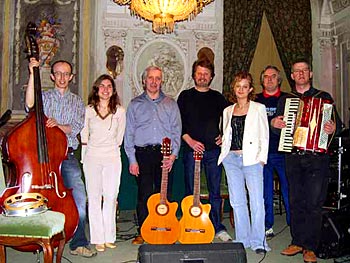
"Furvaji Munfrin-i" is the second CD from Moncalvo-based Il Canzoniere Monferrino, who a few years back issued a great disc called "Al prinsi e al nini," which had a few tracks later included on Monferrini in America's disc, "Reis Monfrin-e."
Now more than 30 years old, the group -- led by singer and percussionist Renato Rossi -- also includes guitarists Dario Corino and Dino Bertolotti, singer Emily Follador, bassist Gianluca Alasio and accordionist Mario Moro.
The new disc has 22 tracks and opens with a stirring pair of melodies from Evlisa Iride Fresia Mortarotti. What follows is an engaging tour of music from Moncalvo, the Monferrato and Piemonte. There are familiar tunes like "Bella ciao," "La monigheta" and "Giacu Trus," as well as perhaps lesser-known songs such as "La furmija e 'l gril," collected at nearby Alfiano Natta, and "La Cichin-a," found at Grazzano Badoglio."
Contact Il Canzoniere Monferrino through Renato Rossi, Via Cissello 12, 14036 Moncalvo (Asti), Italy.
DVD highlights the "Terra di Scrittori"
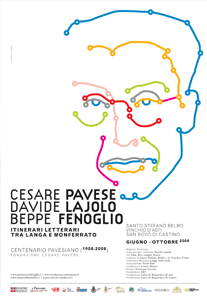
Cesare Pavese, Beppe Fenoglio and Davide Lajolo -- these were the great voices of the Langhe and the Alto Monferrato and their links to the land are explored in a new 15-minute DVD directed by Silvio Ciuccetti and created by Lajolo's daughter Laurana Lajolo.
With lovely photography and narration in Italian, English, French, Spanish and German, this DVD is gorgeous and accessible to most everyone in the western world.
Taken in concert with the literary itinerary available at DavideLajolo.it, "Terra di Scrittori" serves as a fine introduction to these important Italian and Piemontese writers.
To find out how you can obtain a copy, contact Laurana Lajolo via e-mail.
La
Maschera della Donna. Feminine Masks
in the Carnivals of
Piedmont
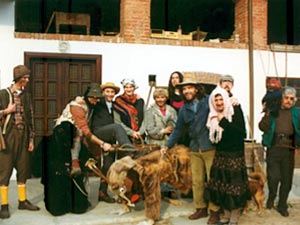
"This volume collects all the contents of the photo exhibition "La Maschera della Donna. Feminine Masks in the Carnivals of
Piedmont,"which took place during the celebration of Women's History
Month, at Mary Washington University, Fredericksburg, VA, March 10-30,
2008.
Following a string of earlier events that started with the exposition "Bestie, Santi, Divinita'" (Turin, winter 2003-04), and continues
through the research of the "Laboratorio Etno-Antropologico" of Rocca
Grimaldi (AL), and the photo exhibition "Dei Selvatici. Orsi, lupi e
uomini selvatici nei carnevali del Piemonte," which was the main event
for the Carnival 2007 of Maison de l'Italie -Ð Cite' Internationale
Universitaire of Paris, this exhibition wanted to give its visitors
the opportunity to meet a lesser known aspect of the Italian folklore.
For the occasion of Women's History Month the main topic of this collection of photos was woman masks used in Piedmont's traditional
carnivals. The photos exposed were taken by Piercarlo Grimaldi
(Universita' degli Studi di Scienze Gastronomiche) and by Davide
Porporato (Universita' del Piemonte Orientale) in nine different
carnivals across Piedmont. In this respect the event represented a
rewarding experience of International collaboration.
The exhibition, and this book, were made possible thanks to the support of the Simpson Program in Medieval Studies, the Department of
Modern Foreign Languages at UMW; the Program of Italian Studies at
UMW, UMW Women's History Month, and Universita' Piemonte Orientale:
Facolta' Lettere e Filosofia
Download a PDF of the exhibition catalog here (click on the catalog cover image to start download).
--Michele F. Fontefrancesco & Federico Schneider
Famous Sardi's restaurant founded
by Monferrini

Most every American knows that Sardi’s is one of New York’s top restaurants and one favored by Broadway stars -- whose caricatures adorn the walls -- for nearly a century now. But, did you know that Vincent Sardi -- who opened the restaurant on 44th Street in Hell’s Kitchen, where many piemontesi settled, in 1921 (it moved to its current location down the street in 1927) -- was born Melchiore Pio Vincenzo Sardi in San Marzano Oliveto Dec. 23, 1885? He spent much of his youth in nearby Canelli, before shipping off to London with an uncle to work in an Italian restaurant. He came to America in 1907.
Sardi’s future wife, whom he called Jenny, was born in Castell’Alfero, July 14, 1889. Giovanna Eugenia Pallera was the daughter of Gioanni Pallera and Emilia Martinetto, who lived in borgata San Sebastiano. She also arrived in New York in 1907.
Vincent died in 1969 and his son, Vincent Jr. ran the restaurant operations until his death in 2007. Jenny passed away in 1978. In 1953, Vincent Sardi published a memoir, “Sardi’s: The Story of a Famous Restaurant."
--Bobby Tanzilo (With thanks to Tiziano Toniolo)
Santa Fede Abbey a jewel in need of polish
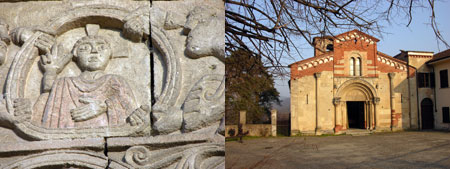
A kilometer from Cavagnolo, a town along the road from Casale to Torino, is the Abbey of Santa Fede. A "jewel shrouded in mystery" discovered in the 19th century by count Edoardo Arborio Mella (restorer of the Duomo in Casale) and defined by superintendant Mesturino in 1953 as "a Roman bon bon in Piedmont." The portal from 1100 is precious and rich with details: figures, vine leaves, grapes, flowers. In the lunette there is Christ among the almonds. At the summit the palm cross, symbol of the Benedictines of Cluny.
Unfortunately the architrave is damaged by a crack and the seeping moisture on the main altar is dangerous. The Marist fathers, to whom the complex is entrusted have for some time now been seeking funding for restorations that are more urgent now than ever.
A un chilometro da Cavagnolo, paese lungo la Casale-Torino, si trova
l'abbazia di Santa Fede. Un "gioiello nascosto e misterioso" scoperto
nell'Ottocento dal conte Edoardo Arborio Mella (restauratore del Duomo
di Casale) e che il soprintendente Mesturino nel 1953 defini' "la
bomboniera del romanico in Piemonte." Pregevole il portale del 1100
ricco di particolari: figure, pampini, grappoli, fiori. Nella lunetta il
Cristo in mandorla. Al culmine la croce palmata, simbolo dei Benedettini
di Cluny.
Purtroppo l'architrave e' lesionato da una crepa, altrettanto pericolose
sono le infiltrazioni d'acqua nella zona dell'altare maggiore.
I padri Maristi, a cui e' affidato il complesso, sono da tempo alla
ricerca di finanziamenti per restauri quanto mai urgenti.
--Luigi Angelino
The dialect poetry of Albino Defilippi

Alfredo Frixa, webmaster of the town Web site (www.comune.treville.al.it), offers visitors the chance to read and download at no cost the dialect poems by the Treville's Albino Defilippi (1859-1939). These poems were researched by Frixa (whose maternal grandmother was a native of Treville), with the intent to rediscover and preserve the town's traditions.
Albino Defilippi was born in Treville in 1859 to a farming family. Married to Vincenza Ghione, he had only one son, Teofilo, who was mysteriously assassinated by an unknown person in Turin. The poet died in Treville in 1939 and was buried in the old part of the town cemetary, specifically in the chapel reserved for members of the Fraternal Order of SS. Sacramento (i Batu), of which he was a part.
His poems were in a large part contained in two collections published in 1931 and 1939, entitled "The Last Songs of Albino Defilippi" -- a good meal of good soup and good dishes -- and "My Last Songs." Another five poems were published on the Trevillese site, among which the most famous "The Song of Treville" (sung by the Trevillese in the first half of the 1900s, on their pilgrimages to the Sanctuary of Crea) and "The Sulphuric Fountain" which at the moment are not included in any collection. These extremely rare collections are part of private collections and were rediscovered in an antique store.
The originals were written by hand on various notebooks, constructed by him with pages from a religious calendar (Defilippo was also a Franciscan Tertiary), and conserved in Treville's Parish Archives.
English translation by Angela Ziino.
In questi giorni, Alfredo Frixa, webmaster del Sito Comunale (www.comune.treville.al.it), offre ai visitatori del Sito la possibilità di leggere e scaricare gratuitamente le poesie dialettali composte dal trevillese Albino Defilippi (1859-1939). Queste poesie sono state ricercate da Alfredo Frixa (la cui nonna materna era nativa di Treville), nell'intento di riscoprire e non perdere le tradizioni trevillesi.
Albino Defilippi, contadino e poeta dialettale, nacque a Treville nel 1859, da famiglia contadina. Sposato con Vincenza Ghione, ebbe un solo figlio, Teofilo, che fu misteriosamente assassinato da ignoti a Torino. Il poeta morì a Treville nel 1939 e fu sepolto nella parte vecchia del cimitero del paese ed in particolare nella cappella riservata ai membri della Confraternita del SS. Sacramento (i Batu), dei quali fece parte.
Le sue poesie sono in gran parte contenute in due raccolte pubblicate nel 1930 e nel 1931, intitolate "Gli Ultimi Canti di Albino Defilippi, ossia un Buon Pasto di Buona Minestra e Buone Pietanze" (Casale Monf., Ed. Tipografia Pezzana e Musso succ. Pane, 1930) ed "I Miei Ultimi Canti", (Casale Monf., Ed. Unione Tipografica Popolare, di Botto, Alessio & C., 1931).
Altre cinque poesie pubblicate sul Sito Trevillese, tra le quali le più famose "La Canzone di Treville" (cantata dai trevillesi della prima metà del '900, nel corso dei pellegrinaggi al Santuario di Crea) e "La Funtanna Sulfurusa", non sono al momento collocabili in alcuna raccolta. Queste raccolte, ormai introvabili, fanno parte di collezioni private o sono state ritrovate nei mercatini d'antiquariato.
Gli originali di Albino Defilippi, scritti di suo pugno su quadernetti di varia forma, costruiti da lui con fogli di calendari religiosi (Albino Defilippi fu anche Terziario Francescano), sono invece conservati nell'Archivio Parrocchiale di Treville.
Alliaudi studies emigration
Among people interested in emigration we would like to introduce the research done by a Piemontese woman in the years 1989-1990. Her name is Mariagrazia Alliaudi and she lives in Pinerolo (province of Turin). She wrote a thesis about the "Features of the Piedmontese Emigration to the United States of America" that had very good results at the University of Turin. This work describes some Piemontese communities that, at the end of the 19th century, left Piedmont, went to the States and it talks about their difficult settlement in the new country. The main communities studied are the miners from Canavese, who worked in the mines of Wisconsin and Minnesota, the farmers from Cercenasco to the Galveston County in Texas, the Waldensians to North Carolina, the weavers from Biellese to New Jersey, the winemakers of California, and some others. This survey follows the main steps of the making up of each community to North America and points out how Piedmontese customs, traditions and language have survived. The detachment from the origin village has been only geographical, never affective!
For further details, if you are interested, please contact Silvio Genero at silviogenero@tele2.it.
Genealogical Research Promoted in Marcorengo, Province of Turin, Diocese of Casale
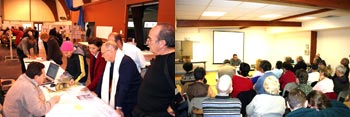
There are people coming from all over the world between the descendants of the old families of Marcorengo. The small Monferrato town of 350 people is located on the first hills of the Po River, almost as a balcony overlooking the Padana Plain, at the intersection of four provinces (Turin, Asti, Vercelli and Alessandria) and in its past many of its inhabitants emigrated to other areas of Italy and the rest of the world.
A big gathering will be organized to make sure that all the descendants , coming from all over the world, would be together, united by their ancestors and by the millennial history of this small town. For such occasion , the person who wishes to know about ancestors baptized, married or who died in Marcorengo parish between the years 1673-1923 can file a request until Dec. 31, 2005.
If the proper form hasn't been already received, it is possible to send ancestors data using the following email address: silvanoferro@libero.it Silvano Ferro, genealogist and local historian, is the promoter of this initiative.
For many people it will be a wonderful surprise to discover about their ancestors living at the same time as Peter the Great, Mozart,Napoleon, Manzoni, just to mention a few examples. The results of such a huge work will be publicized June 2006, during a ceremony organized by the association" Nostre Origini" of Turin, formed to promote Piedmontese culture with events, publications and exhibits. During the event there will be the presentation of Silvano Ferro's book about Marcorengo one thousand years old history.
This book is also a compendium of 30 years of work done by the author. It will explain how the researches were done and it will contain statistics and curious facts about Marcorengo.
Don't miss this opportunity to participate! For more information about the author and his work go to www.silvanoferro.it.
-Translation by Claudia Pessarelli
La Ricerca degli Antenati Promossa a Marcorengo, in Provincia di Torino, Diocesi di Casale
antiche famiglie di Marcorengo, in Provincia di Torino, Diocesi di Casale Monferrato. Il piccolo paese del Monferrato (350 abitanti circa) e' situato sulle prime colline del Po, quasi a sporgersi come un balcone sulla Pianura Padana, al confine di quattro provincie (Torino, Vercelli, Asti e Alessandria) e ha avuto molte persone emigrate in varie parti d'Italia e del mondo. Si e' pensato quindi di organizzare un grande raduno che possa per una volta farli incontrare tutti insieme, accomunati dalle loro radici, dai loro avi e dalla millenaria storia della piccola localita'.
Per tale occasione, chi desidera conoscere quali erano i propri antenati che sono stati battezzati, che si sono sposati e che sono morti nel territorio della Parrocchia di Marcorengo dal 1673 al 1923, ha tempo sino al 31 dicembre 2005. Chi non ha ricevuto l'apposita comunicazione, puo' comunicare le generalita' del proprio avo tramite l'indirizzo email silvanoferro@libero.it. L'iniziativa infatti e' promossa da Silvano Ferro, studioso di storia locale e di genealogia. Per molti sara' una bella sorpresa conoscere chi erano i propri antenati vissuti al tempo di Pietro il Grande, di Mozart, di Napoleone o del Manzoni, per fare solo qualche esempio. I risultati di questo lavoro di grosse proporzioni saranno poi consegnati a giugno 2006 nel corso di una manifestazione, una "festa del ritorno" organizzata dall'Associazione Nostre Origini di Torino, costituita allo scopo di valorizzare la cultura del Piemonte con manifestazioni, pubblicazioni, convegni e mostre.
Sempre nella stessa occasione sara' pubblicato un libro sui mille anni di storia del paese, a completamento di ricerche effettuate da Ferro in trent'anni, un libro che spiega come si sono condotti gli studi sugli antenati e un piccolo libro di statistiche e curiosita' varie su Marcorengo. Chi desidera partecipare quindi non perda questa occasione! Maggiori informazioni sull'autore di questa iniziativa e sulle sue pubblicazioni sono reperibili sul suo sito Internet www.silvanoferro.it.
The Magical Figures of "Fubine"
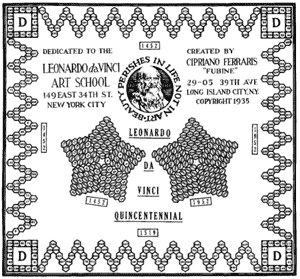 While most of the emigrants from Fubine who went to America worked in bars and restaurants or as garment factory workers, one Cipriano Ferraris made a name for himself in mathematics, according to "The Zen of Magic Squares, Circles and Stars: An Exhibition of Surprising Structures across Dimensions," by Clifford A. Pickover.
Pickover was introduced to the work of Ferraris, who was called "Fubine," by a friend of Ferraris', James Nesi, who had a collection of magic drawings and figures designed by Fubine, who died in 1958. These drawings used shapes and number -- none of which was repeated and the totals of which were invariably identical. When the stock market crashed in 1929, Ferraris lost everything an was suicidal, but distracted himself with these curious and remarkable drawings, which he made mostly during the 1930s. Although based on mathematics, these designs looked almost like folk art, which might explain why according to Nesi -- who gave some of Fubine's designs to Pickover -- professional mathematicians often did not take Ferraris' work seriously.
Some of his designs were displayed in the offices of the National Puzzler's League in New York City, according to Pickover, and one was even displayed at the 1939 World's Fair.
One of those squares had four rows of four columns and each box contained a number. All of the rows and columns, as well as the two diagonals add up to 34 and there are at least 20 more ways to make 34 using the square. Another, more complex, example is pictured above.
The Ellis Island Web site shows that Cipriano Ferraris, then 22, arrived in New York on August 3, 1907 with his wife, Ernesta Gotta Ferraris, age 20. At the time, Ferraris' father Paolo lived at 174 W. Houston St. in Manhattan's Greenwich Village. The younger Ferraris -- pale complected with a scar on his upper lip -- had arrived in New York at least two other times, in 1898 and 1907. Ferraris was 72 when he died on October 30, 1958.
You can see Pickover's book at Amazon.com.
Carlo Albert Cappa had ties to Asti
One of the earliest concert-band performers and leaders was Carlo Alberto Cappa (born 1834). After a solid musical education at the Royal Academy in Asti, Italy, and a short stint as a musician with the Italian Lancers, a military unit, Cappa left for Boston in 1858 to form his own ensemble. Two years later he went on to New York to join one of the nation's leading groups, the Seventh Regiment Band, then under the baton of another Italian, Claudio S. Grafulla, who himself was active in many local ethnic activities. Cappa replaced Grafulla in 1881 and led the band until his death in 1893. Like his predecessor, Cappa seemed to retain an awareness of Italian culture, especially in his musical compositions, which were reminiscent of his native Sardinia (in fact, Cappa was born in Piemonte) and Italy, and participated occasionally in community ethnic activities. Undoubtedly, the commendation he had received from the Italian king for his musical ability must have reinforced his traditional attachments. In addition, in the many performances he gave in New York's Central Park as well as when on tour, he regularly included in the programs of his concerts the bel canto opera pieces.
--from "A Passion for Polka: Old-Time Ethnic Music in America" by Victor Greene, University of California Press, 1992, p. 37
from territorialbrass.com:
Another prominent musician with whom (Achille) La Guardia (father of Fiorello LaGuardia) associated was Carlo Alberto Cappa, trombonist, composer, and bandmaster of the 7th Regiment Band, which performed regularly at Central Park and Brighton Beach, New York. Cappa was highly regarded for his superb musicianship. La Guardia performed as cornet soloist with Cappa's "World Renowned" 7th Regiment Band; therefore, it can be reasonably concluded that he was an outstanding cornetist.
Riso e Rose 2005 arrives
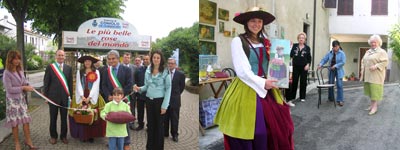
It's time for Riso e Rose (rice and roses) in the Monferrato and the summer-long festival which began with 13 communes now has expanded to include 33 for its fourth edition. With a diverse list of events in towns throughout the zone, the festival -- with displays, food, music, dance and more -- Riso e Rose -- organized by Mondo (Monferrato, domande, offerta) -- is the perfect showcase for the Monferrato summer.
"Riso and Rose is a pretext to get to know ... the parks, the wine cellars, the agritourism sites, the beds and breakfast, but also the panoramic vistas, the castles, the small Romanesque churches -- as well as those designed by Magnocavalli and with paintings by Moncalvo -- to say nothing of Casale, which certainly requires more than a day's visit," says Mondo president Luigi Angelino
(who, incidentally, also took the photos that accompany this story).
Riso and Rose event calendar
Casale Monferrato - 9 maggio - Un mondo per Riso and Rose
Coniolo - 15 e 16 maggio - Coniolo fiori
Pontestura - 16 maggio - Risottata in piazza
Camino - 16 maggio - RisAlto
Gabiano - 16 maggio - Vino a corte in una cornice di rose antiche
Rosignano - 15 e 16 maggio - Riso, Rose e Monte Rosa
Mombello - 16 maggio - La Rosa dei venti
Vignale - 15 e 16 maggio - Rosa dell'Enoteca - Riso e risate
Treville - 16 maggio - I passi delle ore
Parco del Po, Bozzole, Frassineto Po, Giarole, Mirabello, Occimiano, Pomaro, S. Salvatore - 16 maggio - La Cavalcata della Rosa
Valenza - 16 maggio - Bouquet di maggio
Conzano - dal 15 al 23 maggio - Les Te'ne'bres ... mais la rose
Moncalvo - dal 15 al 23 maggio - Risi, sorrisi e rose
Murisengo - 22 e 23 maggio - Il Mercatino in rosa
Villamiroglio - 23 maggio - SorRiso e Pois
Terruggia - 22 e 23 maggio - Io, tu e le rose
Ozzano - 23 maggio - Ditelo con le rose
Sala - 23 maggio - Rosa antico
Cella Monte - 23 maggio - Le colline sono in fiore
Olivola - 23 maggio - I giardini di Olivola
Balzola - 23 maggio - Con le due ruote tra le risaie
Parco del Po e Rivarone - 23 maggio - La camminata della Rosa
Casale Monferrato - 23 maggio - Il giorno dei Gonzaga
To learn more, click here.
The city of gold displays its treasures
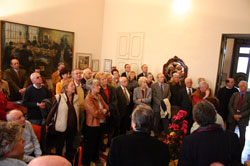 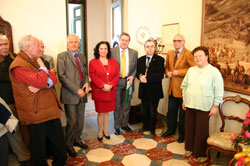
Some 60 tourism experts and buffs visited Valenza, the city of gold, on Saturday, March 19, 2005
as part of a tour promoted by the Italian Touring Club, and organized by TCI consuls Luigi Angelino
(of Il Monferrato) and Tom Cerrato of Asti. They were received by the Vice Sindaco (vice mayor) Gianni Raselli, who delivered a warm welcome on behalf of the city's "first citizen," Mayor Germano Tosetti,
who was suffering from the flu, and by assessors Giorgio Manfredi and Daniela Di Spirito.
Guiding the group were Manfredi and Carlo Dabene at Palazzo Pellizzari, engineer Enzo Evaso at Santa Caterina, Maria Grazia Molina at the Sala Illario in Villa Scalcabarozzi, home of the Goldsmiths' Art Collections, and the duomo. Goldsmith Giancarlo Tassinario explained how a piece of jewelry is born, demonstrating a typical goldsmith's bench and some antique equipment. Finally, the group went to the Palazzo Valentino to admire the modern structure and for a tasting of amaretti Margherita from the Torti pastry shop, along with Saccoletto-produced wines from the regional enoteca in nearby Vignale.
Il Monferrato inaugurates new offices
 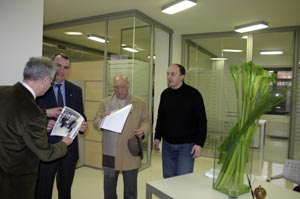
Piemonte regional president Enzo Ghigo cut the ribbon inaugurating the new offices of Casale's
Il Monferrato newspaper -- which covers the entire Monferrato -- on Saturday, Feb. 5, 2005.
Among those president at the bright, modern new offices in viale Cavalli d'Olivola were prefect
Vincenzo Pellegrini, provincial president Paolo Filippi, mayor Paolo Mascarino and Mario Berardi, president
of the Order of Giornalists in Piemonte. Cardinal Severino Poletto closed the day's events with a benediction. (foto Furlan)
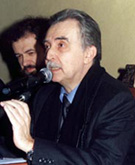 Angelino tapped to lead Mondo Angelino tapped to lead Mondo
Luigi Angelino of Il Monferrato, the newspaper in Casale Monferrato, was unanimously elected president of Monferrato tourism promotion society Mondo. Angelino was the choice of Casale mayor Paolo Mascarino. In addition to coordinating events like the great Riso e Rose festivals in towns throughout the Monferrato, Mondo is currently working on a project to bring a new museum of contemporary art to Casale. You can read an interview with Angelino here. The interview is in Italian. After clicking the link, scroll down until you find the headline, "Le sinergie di Mondo."
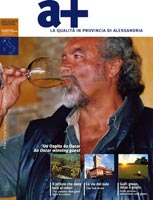 Lavish A+ magazine trumpets treasures of Provincia di Alessandria Lavish A+ magazine trumpets treasures of Provincia di Alessandria
With two issues already out and a third on the way, A+, the new quarterly magazine celebrating the Province of Alessandria is itself a treasure. As thick as a book and loaded with lovely photos and a great design, the magazine has articles about travel, art, architecture, history, food, wine and other aspects of the region. Luckily for those who aren't fluent in Italian, all the articles are also presented in English, too. Issue three is due on newsstands on September 1. You can learn more about A+ and how to receive it at www.infoapiu.it.
Crea earns Unesco distinction
In July 2003, Crea, along with six other Sacri Monti in Piemonte and Lombardia, was
declared a World Heritage site by Unesco. A plaque commemmorating the distinction
was erected at Crea in a ceremony on May 22, 2004.
Antique trades fair visits Conzano
 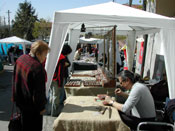
The 17th Fiera degli Antichi Mestieri -- or
antique trades fair -- kicked off in March in Cavour, in the
province of Torino, in May and visits a new town each month, ending
at Albenga on the Italian riviera in July. On April 10-12, it set up shop in Conzano in the province of Alessandria.
The fair promotes artisans who create art and other works using age-old traditions. To learn more
about the fair, click here.
These photos are courtesy of Luigi Angelino and Il Monferrato newspaper
in Casale (which, incidentally, offers affordable subscriptions
to overseas readers. Visit the Web
site for details.)
Catch the spirit Munfrin!
 The
Assessorato per la Cultura for the city of Casale Monferrato has
published a wonderful anthology of poetry, songs and satire in the
dialect of the Monferrato Casalese. "Spirit Munfrin"
edited by Elio Botto, Teresio Malpassuto and Giorgio Milani has
more than 200 pages of works in dialect by Monferrini poets and
writers. There are also translations (into Italian but not English)
and short biographical sketches of the writers. There are also some
really wonderful old photographs by Francesco Negri, who died in
1924. What makes them special is the fact that they depict scenes
of everyday life, from work in the fields and rice paddies to children
playing and adults dancing. We've all seen historical photos
of the towns of the Monferrato or posed photos of people, but not
these lively pictures that open up a disappeared world to us. The
Assessorato per la Cultura for the city of Casale Monferrato has
published a wonderful anthology of poetry, songs and satire in the
dialect of the Monferrato Casalese. "Spirit Munfrin"
edited by Elio Botto, Teresio Malpassuto and Giorgio Milani has
more than 200 pages of works in dialect by Monferrini poets and
writers. There are also translations (into Italian but not English)
and short biographical sketches of the writers. There are also some
really wonderful old photographs by Francesco Negri, who died in
1924. What makes them special is the fact that they depict scenes
of everyday life, from work in the fields and rice paddies to children
playing and adults dancing. We've all seen historical photos
of the towns of the Monferrato or posed photos of people, but not
these lively pictures that open up a disappeared world to us.
Even a vague knowledge of Italian will be enough to give American
readers an idea of what the songs and poems are about and to read
the dialect of our forebears is exciting and insightful. The book
is a bargain at 8 Euros and you can learn about ordering it by clicking
here
(then click on "La citta' storica" and "pubblicazioni").
Meridiani readers meet the Monferrato
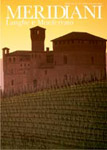 A
slick, lovely Italian magazine called Meridiani, which is nearly
a book it's so thick, featured the Monferrato and the Langhe
together in the October 2003 issue. A
slick, lovely Italian magazine called Meridiani, which is nearly
a book it's so thick, featured the Monferrato and the Langhe
together in the October 2003 issue.
Loaded with photos, maps and page upon page of travel info (hotels,
bed and breakfasts, restaurants, museums, etc.), the magazine
also has interesting stories about history, gastronomy, wine, castles
and more. What's nice is that the magazine's staff looked
beyond cities like Asti, Casale and Acqui to also talk about small
town life in the region.
We found our copy at Chicago's Europa Books in January, so
your local international bookshop or newsstand may have a copy now.
If not, you can buy back issues online
at www.meridiani.com.
Connecticut poultry king Henry Saglio
dies at age 92
Glastonbury, Connecticut poultry king Henry Saglio, whose parents emigrated to the United States from Fubine and nearby Cuccaro, died December 13 at a nursing home in Connecticut. He was 92. There have been numerous obituaries detailing the achievements of Saglio, including one in the New York Times in which Frank Perdue called Saglio, "the father of the poultry industry."
"He was really proud -- and rightly so! -- of the role that he played in
world-wide nutritional and economic issues," his niece Ginny Lukasik told us. "I'm
glad you honored him by your mention of his death -- he was a fabulous and
honorable person with a good sense of humor -- I hate to think of
Thanksgivings without him!"
To read the entire New York Times obit from Sun., Dec. 21, 2003, click here.
Rocchietti penned first Italian-American novel
When Carol Bonomo Albright took a chance on a rare book being offered by a liquidating antiquarian bookseller, she re-discovered the earliest-known Italian-American novelist. Joseph Rocchietti emigrated from Casale to the United States early in the 19th century and penned "Lorenzo and Oonalaska," a novel about a man who flees Piemonte in the wake of the Austrian invasion and meets Oonalaska, the daughter of an upper class Englishman.
"What is striking about the novel is its blend of Italian and American ideals of the time," Bonomo Albright wrote in the Summer 2000 issue of "ItalianAmericana, "each reflecting the philosophy of the Enlightenment with its emphasis on reason and truth, and its questioning of the divine right of kings."
We recently met Bonomo Albright, who is preparing new editions of the works by Rocchietti that she's uncovered. She's also working on a biography of the author, whose works did not go unnoticed in his day. Edgar Allan Poe even reviewed one of his books.
As Bonomo Albright learns more and shares it with us, we'll let you know. In the meantime, you can find her two articles on Rocchietti in two issues of "Italian Americana," Summer 2000 and Summer 2001.
Missed the truffle fair?
Moncalvo's 46th annual truffle fair took place beneath the portici and in Piazza Carlo Alberto
October 19-26. Our friend Fabrizio Raiteri, sent this photographic report.
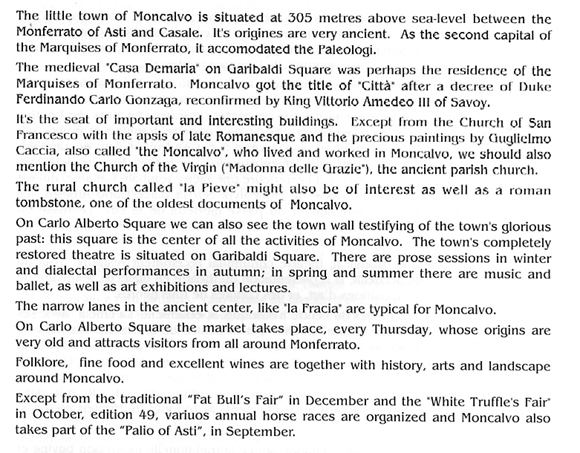
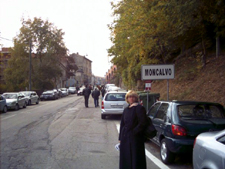 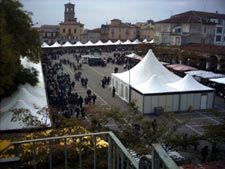
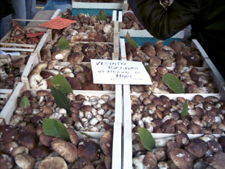 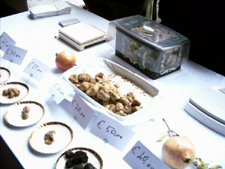
Some more Monferrato Web sites
Silvano Cerrato continues his great work with a
Web site that lists all of the towns in the area and has photos
and other information on each one. There is also historical information
and more at his www.ilmonferrato.info.
Meanwhile, you can step back into the medieval Monferrato at www.astiantica.com,
which also has photos, plus heraldic info, historical details and
more.
The very active Piemontesi nel Mondo group in Northern
California also has a Web presence now. Visit it at www.piemontesinoca.com.
There is also a great Web site called La
Lingua Piemontese that has an online language course in Piemonteis.
Best of all, it's available in Italian, English, Spanish, French,
and, of course, Piemonteis.
81st La Fubinese Society
Inc. Luncheon
The dinner dance survives another year!
La Fubinese Society Inc. Luncheon
Sunday, November 16, 2003
Ricardo's Restaurant, 24th Ave. & 21st St., Astoria, Queens, NY
cocktail hour, 1-2 p.m., dinner dance, 2-6 p.m.
$50 per person, includes dinner, dessert, coffee, two bottles of
wine at each table, gratuity and, believe it or not, an open bar
throughout the affair!
Questions? Want to buy tickets? Call Ronnie Longo
(718) 767-4163.
The fascist era lingers
 Some of you may have seen this poster for sale Some of you may have seen this poster for sale
on the Internet, where t-shirts bearing its image can
also be purchased. Before being lured by the phrase
"Legione Monferrato," take note of the M.V.S.N.
next to it.
The Milizia Volontaria di Sicurezza Nazionale was
the militia created by Mussolini's fascist administration.
The official creation of the militia meant that the
previously unpaid Blackshirts would now receive a wage for their work, which,
in 1924, included the murder of Matteotti.
See Alexander Ganse's Web page for information on the M.V.S.N.
Una canson di Tarvilla
About four years ago Monferrini musicians Alfredo
Frixa and Gian Piero Morano uncovered an old song celebrating the
town of Treville. The pair assembled a chorus of local youngsters
to perform their arrangement of the song along with Frixa on acoustic
guitar. They performed it at a Treville festa and recorded it. Click
here to download
an Mp3 of "Viva Tarvilla," a typical Monferrini folk song, written by Trevillese poet Albino Defilippi (1859-1939).
S'la
punta d'la culin-na
ai e' pianta' Tarvilla
la vista dal Munfra'
l'e' il pais pu ben pianta',
pu ben pianta'
El funtanin dal surfu
L'ha na virtu' speciale
El vin l'ha pu vigur
Mei che l'acqua di dutur,
e di dutur
E viva Tarvilla tati'c e tato'c
a l'e' al pais ad iarticioc, ad iarticioc
E viva Tarvilla tati'c e tato'c
a l'e' al pais ad iarticioc, ad iarticioc
La ciesa d'la campagna,
San Quili l'e' numaia
L'e' iun di cui mudei
d'arte antica di pu bei, e di pu bei.
La gent l'e' tant tranquilla,
l'effet d'la camomilla
ai e' omni, fie e fioi
Chi sun propri i nost argoi, i nost argoi
E viva Tarvilla tati'c e tato'c
a l'e' al pais ad iarticioc, ad iarticioc
E viva Tarvilla tati'c e tato'c
a l'e' al pais ad iarticioc, ad iarticioc
E nui tuc ad Tarvilla glurius d'la nosta villa
criumma a pien dirit
Viva viva il nost bel bric, il nost bel bric.
|
On
the top of the hill
Treville is embedded
the sight of the Monferrato
it is the country better embedded, better embedded.
The sulphurous small fountain has a special virtue
the wine has more vigor
and it is better than the water of the doctors, of the doctors
It's alive Treville tatic and tatoc
it's the country of the artichokes, of the artichokes,
It's alive Treville tatic and tatoc
it's the country of the artichokes, of the artichokes,
The rural church is named St. Quili (San Quirico)
it's one of finest model
of ancient art, of the finest (model).
People are very calm
(due to) the effect of the camomile
the men, the girls and the boys
here they really are our pride,
our pride
And all of us from Treville,
proud of our village,
we shout by full right
long live to our beautiful hill
to our beautiful hill. |
Sulla
punta della collina
e' "piantato" Treville
la vista del Monferrato
e' il paese meglio "piantato,"
meglio "piantato."
La fontanella solforosa,
ha una virtu' speciale
il vino ha piu' vigore
ed e' meglio dell'acqua dei dottori, e dei dottori
E viva Treville tatic e tatoc
e' il paese dei carciofi,
dei carciofi
E viva Treville tatic e tatoc
e' il paese dei carciofi,
dei carciofi
La chiesa di campagna
e'
chiamata San Quirico
e' uno di quei modelli
d'arte antica dei piu' belli,
dei piu' belli.
La gente e' tanto tranquilla
l'effetto della camomilla
gli uomini, le ragazze ed i ragazzi
qui sono proprio il nostro orgoglio, il nostro orgoglio
E noi tutti di Treville
gloriosi (orgogliosi)
del nostro paese
gridiamo a pieno diritto
viva viva la nostra bella collina,
la nostra bella collina.
|
Monferrini mourn the loss of historian and restaurateur Frances Robotti & doctor Louis Lasagna
Frances Robotti, a Manhattan restaurateur and popular historian, died Aug. 3, age 93. With her husband, Fubine native Peter Robotti, she was the proprietor of Le Chateau Richelieu, a fancy restaurant on East 52nd Street specializing in continental cuisine. Mr. Robotti, an Italian immigrant, became proprietor in 1929. Although the place was raided a few times during prohibition, it came to be regarded as one of the leading French and northern Italian kitchens in the city.
"Much Depends on Dinner," published in 1961 with both Robottis listed as
authors, delved into the evolution of manners and customs of cuisine,
starting in the ancient world. It also included hints for both diners and
staff for correct behavior, including tips on tipping, wine ordering, and
keeping the table clean. Reviewing the book, Craig Claiborne wrote, "A
waiter 'is attentive to the guest, seeing that the tablecloth is kept clear of crumbs and, if an accident occurs with food, water or wine, he corrects it quietly with a fresh cloth.' This will of course bring for cynical amusement from much of the reading public."
Also included were a number of interesting anecdotes, including the fact that the author Thomas Wolfe used to frequent Le Chateau Richelieu. "He
would sit over in a corner, never bother anybody and would drink 10 or
12 Cointreaus."
As for the restaurant itself, in a New York Times review from 1973,
Raymond Sokolov gave it a single star, calling it inconsistent. "This is a
big, boastful and not at all ugly French restaurant with luxury prices," Mr. Sokolov wrote, complaining about the pate, soup, sauces, and desserts. Two years later, though, the Times's John Canaday pronounced it "excellent,"
while cautioning that the prices were high. "It doesn't sound expensive,
with plats du jour as low as $7," he wrote. "But the necessity of choosing
between caution and bankruptcy does take the edge off a meal."
Mrs. Robotti was born to a Jewish family in Los Angeles, where her father
was in the fur business. The family
moved to New York after her mother died, while she was in high school. She
attended Hunter College, majoring in Latin and Greek before teaching at the
Professional Children's School. She often served as hostess at Le Chateau Richelieu, and she wrote two further books on food, "French Cooking in the New World" (1967), and "Key to Gracious Living: Wine and Spirits" (1973).
The restaurant closed in 1983 and Mr. Robotti died in 1988.
During his lifetime, Mr. Robotti was a benefactor of his hometown of
Fubine, Italy. His donations went to repair the cathedral, build a school,
and support an orphanage. He was buried there, and Mrs. Robotti's body was buried next to his in a private funeral on Aug. 12.
Frances Diane Robotti, born in Los Angeles, died in New York on Aug. 3, of heart failure. She is survived by an adoptive son, Armando Visentin Robotti.
Louis Lasagna, the son of Monferrini emigrants, Louis Lasagna, died in Newton, Mass., on Aug. 7 of lymphoma. He was 80. Born in Queens, New York in 1923, Lasagna graduated from Rutgers in 1943 and earned a medical degress from Columbia University in 1947. Lasagna was a respected clinical pharmacologist who pioneered the study of placebos and wrote an alternative Hippocratic oath.
He is survived by his wife Helen, seven children and eight grandchildren.
Respected songsmith Paolo Conte
e' un monferrino
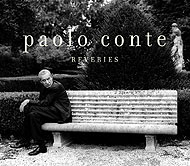 Paolo
Conte was born 6 January 1937 in Asti and has had a lifelong passion
for jazz and the visual arts. He and his brother Giorgio, and
then he alone, would write songs inspired by books, films and
from actual experience. Conte worked for several years as a lawyer.
His performing career began on a small scale as a vibraphone player
in local and touring bands, with occasional foreign trips. Paolo
Conte was born 6 January 1937 in Asti and has had a lifelong passion
for jazz and the visual arts. He and his brother Giorgio, and
then he alone, would write songs inspired by books, films and
from actual experience. Conte worked for several years as a lawyer.
His performing career began on a small scale as a vibraphone player
in local and touring bands, with occasional foreign trips.
In the second half of the 1960s his compositions drew notice and
popular singers began to record his music. For the first time
the public heard these strange, unusual songs: "La coppia
piu' bella del mondo" (Adriano Celentano), "Insieme
a te non ci sto piu'" (Caterina Caselli), "Tripoli
'69" (Patty Pravo), "Messico e nuvole" (Enzo Jannacci),
"Genova per noi" and "Onda su onda" (Bruno
Lauzi), and many others.
Conte's solo debut appeared in 1974. He gained widespread
public recognition with "Un Gelato Al Limon" and "Paris
Milonga," which were presented in 1981 at a special "Conte
Day," organized by the Club Tenco at San Remo. Conte's
US debut, The Best of Paolo Conte, was released in 1997. Nonesuch
recently released his latest disc, "Reveries."
Fubinese-American musical treasure
unearthed!
As we've been working to document the history of La Fubinese Society
of New York, with the invaluable assistance of Ronald Longo, we
were thrilled to hear the 10" 78 rpm record that Ronnie sent
us. The disc, which appears to have been a one-off or at least
an extremely small pressing, features former La Fubinese member
Joseph Cerrina singing "La Canzone di Fubine" (in dialect!)
on one side, and his version of "Piemontesina" on the
flip side. Cerrina is accompanied by an acoustic guitar. Click
here to listen to both songs.
The record is scratchy, so I will likely enlist an expert to clean
up the Mp3. But, in the meantime, feast your ears on these gems!
Grignolino making a comeback
in America
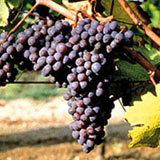 Older
Piemontesi-Americans can likely remember a time when grignolino,
freisa and ruche were available in the United States, at least
in Piemontese neighborhoods like the one on Manhattan's West Side.
Ads from the 1920s and '30s boast of wine importers and distributors
who catered to these communities by supplying the wines they treasured.
Alas, those days are long gone. Older
Piemontesi-Americans can likely remember a time when grignolino,
freisa and ruche were available in the United States, at least
in Piemontese neighborhoods like the one on Manhattan's West Side.
Ads from the 1920s and '30s boast of wine importers and distributors
who catered to these communities by supplying the wines they treasured.
Alas, those days are long gone.
But there are a handful of American winemakers
that have discovered the joyful spiciness of grignolino and are
making it, even if it's only in small quantities. Click here
to read an article about Stone's Throw, a Wisconsin winery run
by Russell Turco (who is half Piemontese, half Modenese), that
makes a delicious grignolino.
You can visit Stone's Throw's Web site here.
Guglielmo in California also makes a grignolino,
which you can buy via their Web site. Click here
to visit it.
Pavese finally finding a place
in American publishing world
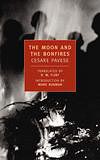 New
York Review of Books has published selected works by the great New
York Review of Books has published selected works by the great
Cesare Pavese, including the landmark, "The Moon and the
Bonfires" ("La luna e i falo'"), which has
just won another award. Here is the official press release. Meanwhile,
look for that title and "The Selected Works of Cesare Pavese"
in bookstores
everywhere. Pavese would appreciate the prize. He spent many years
working to translate great American literature (by Faulkner and
others) into Italian.
The PEN/Book-of-the-Month Club Translation Prize ($3,000) is given
for a distinguished book-length translation from any language
into English. The PEN/Book-of-the-Month Club Translation Prize,
the oldest award for literary translation in the United States,
was first given in 1963, and is made possible by the ongoing support
of the Book-of-the-Month Club. This year's award recipient
is R.W. Flint for his translation from the Italian of "The
Moon and the Bonfires" by Cesare Pavese (New York Review
Books).
Murisengo's Lavazza launched an empire of coffee
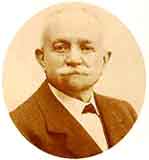 Luigi
Lavazza's name is a household word in Italy and many other countries
throughout the world. Now, it looks like Lavazza,
based in Turin, is looking to make some inroads in the United
States. Just the other day I got an advertising piece with some
coupons from Lavazza in my mailbox. That reminded me that the
company's founder Luigi Lavazza was Monferrino. Luigi
Lavazza's name is a household word in Italy and many other countries
throughout the world. Now, it looks like Lavazza,
based in Turin, is looking to make some inroads in the United
States. Just the other day I got an advertising piece with some
coupons from Lavazza in my mailbox. That reminded me that the
company's founder Luigi Lavazza was Monferrino.
Lavazza was born in Murisengo in 1859 to a family of farmers.
As for most Monferrini farmers, life was hard and Luigi headed
to Turin in 1885 with 25 lire in his pocket, hoping for better
times. He worked hard during the day and attended business school
at night. In 1895 he opened a grocery store and perfected his
own blend of coffee. The rest, as they say, is history.
So, head to your local grocery shop and buy a bag of Lavazza coffee.
Then hit Target and pick up a Bialettti caffetiere (they sell
'em there now, too!) and you can have a taste of the Monferrato
in Montana, Florida, California or Wisconsin!
A Michigan Piemonteisa needs our help!
Sara Rice, whose grandmother and great-grandparents came from
Canavese and settled in Houghton County, Michigan, is working
on a master's thesis at Western Michigan University about Northern
Italian Women in Houghton County. Most of the Italian families
there are originally from Piedmont, she says.
My interest has to do with work and leisure activities of both
first and second generation Italian women between 1880-1920. I
have been using archived documents, genealogies, Italian newspapers,
photos, etc. Most are primary documents, since there is not much
written about Italian women. I have most of my research done,
but I need to conduct some oral histories of women who either
migrated to Houghton county, their daughters or even grandaughters.
I know that many of the Houghton County Italians
migrated into Wisconsin and Chicago areas.
Contact Sara Rice, 2827 Seamers St., Kalamazoo, Michigan 49048.
Email her at sararice2@netzero.com.
The turkey takes the blame in Tonco
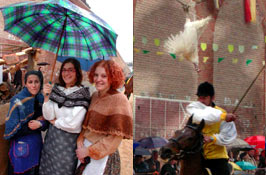
The Giostra del Pitu', held the first Sunday of Lent (March
30, 2003), derives from an ancient rite performed by farmers and
derived from the still older tradition of banishing evil spirits
at certain times of the year and persecuting a scapegoat for all
the ills of the past year. In this case, a pitu' (turkey)
is put on trial and condemmed, but is allowed to make its last
will and testament, a highly satirical and amusing comment on
local mores. A parade of figures in costumes precedes the trial
and the public is offered candlesticks, baked goodies and wine.
Animal rights activists have protested the event as being cruel
to turkey and the festval appears to be in danger of dying out.
Click here
to see Vittorio Ubertone's photos of the event.
Christopher Columbus -- Genovese or Monferrini?

Cuccaro, in the province of Alessandria, and a few miles northwest
of the city of Alessandria, has, for many years, claimed Christopher
Columbus as a native son. The documentation is apparently unclear,
because the issue still seems to be open, but Columbus was apparently
born in Cuccaro, a town of about 400, where he family had lived
for generations, and moved with his family, as a child, to Genoa.
Of course, in Genoa, Columbus' house is a museum open to the public.
There are records that appear to prove that some branches of the
Columbus (Colombo in Italian) family were in Cuccaro, but the
battle is over Cristoforo himself. It's sure to be a heated argument
and maybe we'll never know for sure, but it's interesting to read
about. If you can read Italian, you can learn more by clicking
here.
In the photos above, you can see a fresco at Cuccaro showing Columbus'
discovery of the new world and one of the three Columbus monuments
in the Monferrato town.
Fubinesi in America say goodbye to an old friend
Recently we received word that Romolo J. Saglio, who was a member
of La Fubinese Society for more than 60 years and had served as
treasurer for many of those years, passed away in Connecticut,
where he lived Elvira, his wife of 74 years. Here is a brief excerpt
of a death notice from a local paper.
"Romolo J. Saglio, 100, of Hebron ... died Friday (February
14, 2003) at Harrington Court in Colchester. Born June
19, 1902 in New York City, he had lived in Hebron for 94 years.
Mr. Saglio was president of the Hebron Senior Citizens Club for
over 20 years. He was a director of the Connecticut Milk Producers
Association for 10 years, the Hebron Farmers Exchange, the Manchester
Auction Market, and was a delegate to the Agway Farmers Association.
Mr. Saglio was the leader of the Civilian Defense during World
War II, was an assessor for the Town of Hebron for several years,
and was a member of the Commission on Aging for the town. For
60 years, he was a member of the La Fubinese Society and served
as treasurer for many years. After retirement he and his wife
traveled the United States, Europe and South America."
Romolo Saglio is survived by children, grandchildren, great-grandchildren
and even two great-great-grandchilden. He will be certainly missed
and remembered.
Alessandria -- the new Hollywood?
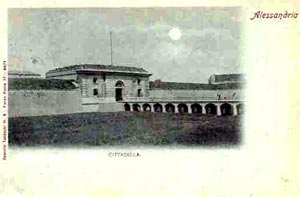
There will be a show at the Citadel in Alessandria in April (originally
scheduled for February) celebrating the 50th anniversary of the
cinematic work of set designer Carlo Leva, who worked with the
likes of Sergio Leone and many other important directors on 144
films and more than 400 television shows. In Hollywood, Leva even
recreated the Sistine Chapel. No small feat, there. At the same
time there will be a show of drawings of costumes
and carriages from Leone films.
At the same time it will reportedly be announced that the Cittadella
(the largest in Europe, it was built in 1700 after the dismantling
of the village of Borgoglio), which has almost been completely
abandoned by
the military, could be used for cinema and television studios.
Word is that it will be renamed Cinecittadella; a nod to Rome's
legendary Cinecitta. The building has many immense spaces that
will make great
locations for any kind of film, it seems. Apparently, some of
the biggest movie makers in the world
will be invited to check it out.
Piemontese historian needs your help
Giancarlo Libert lives in Torino and works, by day, in the financial
sector. But his passion is the history
of Piedmont and he maintains a special love for the story of the
emigration of Piemontesi and the Piemontese diaspora. A fine historian,
Libert is always working hard on projects and has published
many monographs. Lately, he's asking a lot about Piemontesi in
New York and especially about the
societies they started, like the Fubinese Society and groups formed
by emigrants from Casorzo, Asti
and Castell'Alfero. He's also interested in New York City's Mount
Olivet Cemetery, where many
Piemontesi are buried. If you have any information about these
groups or about emigrants from
Piemonte, please contact him at the email address below. No matter
how trivial you may think the
info is, it may be just what Giancarlo needs to point him in the
right direction. If you can write to him in Italian, that's best,
but if not, English will do.
trifula@libero.it
Magnocavallo, architect of the
Monferrato
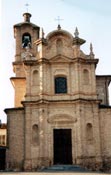 The
Baroque in Piemonte reached some remarkable heights and thanks to
architects like Juvarra and Magnocavallo, even small towns in the
Monferrato have some amazing examples of Piemontese Baroque buildings
(mostly churches). Juvarra, a Sicilian, designed a wonderful tower
in Camagna, but Magnocavallo is a hometown boy and is responsible
for some brilliant works. The
Baroque in Piemonte reached some remarkable heights and thanks to
architects like Juvarra and Magnocavallo, even small towns in the
Monferrato have some amazing examples of Piemontese Baroque buildings
(mostly churches). Juvarra, a Sicilian, designed a wonderful tower
in Camagna, but Magnocavallo is a hometown boy and is responsible
for some brilliant works.
Francesco Ottavio Magnocavallo was born in Casale in 1707 to Ippolito,
conte di Varengo and Contessa Pico Pastrona. He was sent to the
Real Collegio in Parma, run by the Jesuits, and studied letters,
science and especially architecture. Upon finishing he returned
to Casale, where he wrote prose, drama and poetry, as well as essays
on art, music, philosophy and architecture. At a young age he was
nominated mayor of Casale and later he worked for the province and
was in charge of schools and teachers.
When his friend, the count Coppa, asked him to design a house in
Casale, Magnocavallo went to Vicenza and the Veneto to study the
buildings of Palladio. He returned and began an illustrious career
as an architect, designing buildings in Casorzo, Penango, Moncalvo,
Solonghello, Otttiglio, Varengo and other places.
One need only see his regal staircase leading up to the church in
Varengo or the graceful curves in the facade of the little church
in tiny Penango (pictured above) to appreciate his style. This past
year, there was an international congress on Magnocavallo held in
Casale. There were meetings, discussions, concerts, a tour of Magnocavallo's
best works and a performance of his tragedy, "Corrado di Monferrato."
Musica moderna nel Monferrato
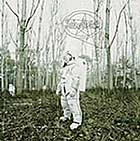 Further
down this page, you'll find information on some traditional music
of the Monferrato. Now for something for the younger readers... Further
down this page, you'll find information on some traditional music
of the Monferrato. Now for something for the younger readers...
Most of the artists on Mescal aren't from the Monferrato, but
the label was founded in 1993 and is based in Nizza Monferrato,
in the province of Asti. Most of the label's acts are on the cuttting
edge of Italian pop music. Mau Mau, Fiamma Fumana, Subsonica,
Monovox and the rest are not schmaltzy opera-wannabe pop singers
doing Italian versions of Barry Manilow songs.
For proof look no further than "Amorematico," the latest
from Torino's Subsonica, released earlier this year. It mixes
rock and roll with techno beats and high-energy songs. The disc
is fairly easy to locate in the U.S. I found mine at Virgin Megastore
in Chicago. Check with shops like that or ones that specialize
in imports.
To learn more about Mescal and its artists, visit www.mescal.it
Get the big picture with Gian
Massimo Torra's panoramiche
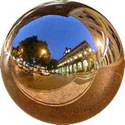
Gian Massimo Torra has taken brilliant panoramic photos of the Monferrato
and you can see them on his Web site, www.torra.it.
Carlo Feltrinelli tells the story
of his father, Giangiacomo
 Although
the Feltrinelli family isn't originally from the Monferrato, Giangiacomo
Feltrinelli, whom this book is about, bought the lofty castle atop
the town of Villadeati in the late 1950s and the family has had
a presence there ever since. Although
the Feltrinelli family isn't originally from the Monferrato, Giangiacomo
Feltrinelli, whom this book is about, bought the lofty castle atop
the town of Villadeati in the late 1950s and the family has had
a presence there ever since.
The Feltrinelli family made its first fortune in timber and quickly
branched out, making investments in all kinds of businesses. Giangiacomo
Feltrinelli was active in the PCI (communist party) in for many
years and helped fund many of its projects.
In the 1950s he began assembling a library of books and other documents
relating to international workers' struggles and movements that
became so big it attracted the interest of the Soviet Union, which
was trying to do similar work at the time. In 1955 Feltrinelli founded
a publishing company that remains one of the biggest and most respected
in Italy. A chain of bookshops was launched the following year.
In 1972, Feltrinelli's death shocked Italy, for a number of reasons.
I don't want to ruin his son Carlo Feltrinelli's book for you, so
I won't go into detail. But the book, titled "Feltrinelli,"
is published in the U.S. by Harcourt and is available in all bookshops.
There is a photo and some discussion of Villadeati and other Monferrini,
like Fubinesi Luigi Longo, make appearances.
Seven hills, 150 producers, one
darn good glass of wine...
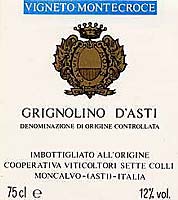 There
are countless wine producers in the Monferrato and many towns have
their own co-ops where small growers can vinify their crops. One
of our favorites is Sette Colli (seven hills) in Moncalvo, on the
road to Casale. There
are countless wine producers in the Monferrato and many towns have
their own co-ops where small growers can vinify their crops. One
of our favorites is Sette Colli (seven hills) in Moncalvo, on the
road to Casale.
Founded in the 1960s, Sette Colli has a membership of more than
150 small producers, who grow Grignolino, Freisa, Ruche, Barbera,
Malvasia and Cortese, as well as some foreign varieties like Chardonnay,
Pinot and Cabernet.
You can visit the co-op online,
but you should really stop in for a visit on your next trip to the
Monferrato. The wine is wonderful and, for an American, dirt cheap!
Locals also bring their own containers to fill from the huge barrels
at a fraction of the cost of the bottled wine. If you go after the
vendemmia, you can also see producers bringing in their harvest
for vinification. The staff is friendly and helpful and will be
happy to see you.
Fiera del Bue Grasso
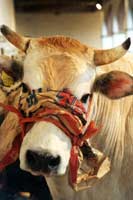 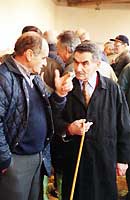
The annual cattle fair takes place in Moncalvo in December because
a Bue Grasso (Fat Ox)
was a traditional farmer's gift at Christmas.
Click here
to see some photos and read more (in Italian).
The Monferrato's Jewish history
survives in Casale
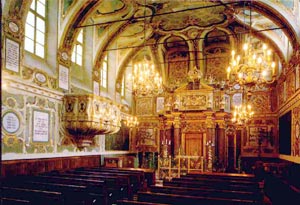
Piedmont had a large Jewish population for centuries. Not only in
Turin, where many Jewish writers like Primo Levi, Natalia Ginzburg
and others lived, but also in smaller cities and towns like Asti,
Casale and Moncalvo. In Moncalvo, the former Jewish cemetery, on
the road to Grazzano, is padlocked and overgrown and a former synagogue
on the main piazza is also closed, all of its contents having been
shipped to a temple in Israel. World War II decimated the Jewish
communities in Piedmont and Alexander Stille has written a fine
book on the subject, called "Benevolence and Betrayal,"
which is easy to find in the U.S. But, you can also learn more at
the synagogue and Jewish museum in Casale.
The synagogue, built in 1595, is located in Salomone Olper alley
and was restored in 1969. It is a fine example of Piemontese Baroque
architecture...inside, that is. The exterior is unassuming thanks
to a law in effect until 1848 that forbade Jews from decorating
the facades of their houses of worship. The museum is one of Europe's
finest Jewish art and history museums and its collection includes
precious objects, embroidery, menorahs and more. You can visit both
buildings on the Web here.
Autumn is festival season...
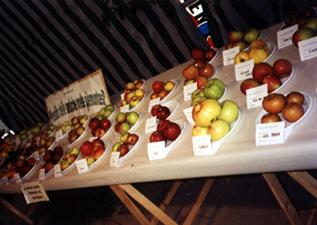
...that means that most every town in the Monferrato
hosts some sort of festival. From processions saluting patron saints
to harvest festivals of all striples, the hills are alive with the
sound of music and more! Recently, we visited the Antique Apple
Fair in Odalengo Piccolo (see photo above), where there were hundreds
of rare apples on display. Farmers in the area are doing their best
to preserve the regional traditions and that includes all kinds
of rare apple breeds. The festival also had music (a one-man band!),
booths selling local food products, crafts and more, as well as
a photo exhibition hosted by a local group of photographers who
specialize in capturing amazing images of the stars and planets.
Just a week later Odalengo also hosted a fair celebrating the local
stone (Tufo) and the local culinary gem, the white truffle (Tartufo).
We purchased some wonderful organic wine, produced in nearby Cardona
(a frazione of Alfiano Natta), and saw a plethora of beeswax candles,
honey and other items that were the work of a family business in
Zanco di Villadeati. The photo exhibit was back on display, this
time in a cascina (farm house), because the city hall was given
over to a display of antique Monferrino clothing and textiles that
formed part of a young bride's dowry. There was also a fascinating
exhibit of nests, hives and fossils discovered in the surrounding
woods.
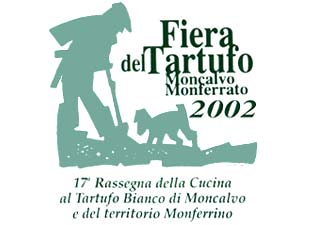
Alba (in the Langhe, not the Monferrato. But close enough to enjoy)
and Moncalvo also had their truffle fairs recently and Asti had
its palio in September, with Alba's donkey palio following shortly
after. Marcorengo had a big festival in September. The list is endless.
Next year, plan your trip for after summer. You can see the vendemmia
(wine harvest), all these great festivals, and, to the north, in
the Po River plain, you'll see the contrasting colors of the rice
fields -- harvested and unharvested.
Another sad loss...Charles Poletti
dies at age 99
Charles Poletti the son of Italian immigrants -- his father Dino
was from Piemonte -- who served as governor of New York in 1942,
and played a major role in the United States Army's reconstruction
of Italy after the fall of Fascism, died Thursday, August 8 at his
home in Marco Island, Florida. He was 99.
In December 1942, Poletti became the first person of 100% Italian
ancestry to become a United States governor, when Herbert Lehman
resigned. Poletti was lieutenant governor. He served only 29 days.
In January 1943, Poletti was appointed special assistant to War
Secretary Henry L. Stimson and in April received an Army commission.
Poletti landed in Sicily the American Seventh Army in July and was
became a senior officer in the Allied Military Government of Occupied
Territory. He was charged with restoring necessary public services.
Poletti was born July 2, 1903 in Barre, Vermont, where many Italians
settled to work as miners. His father came from Pagno (Cuneo) in
1892 and worked as a stone cutter in a granite quarry. His mother
Carolina Gervasini was from Lombardia.
Astute history buffs will also recall that Ella Tambussi Grasso,
also the child of Italian immigrants, became the first woman governor
in American history when she was elected in Connecticut in 1974.
Grasso was born in 1919 in Windsor Locks, Connecticut and died in
1981.
We salute Alan Lomax...
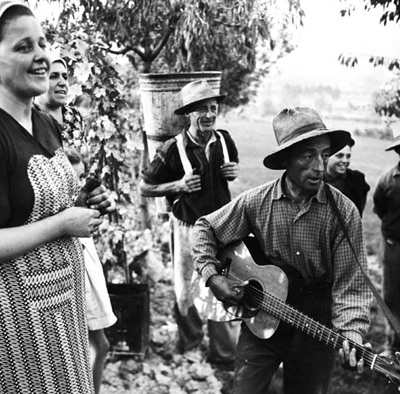
Click here to hear
an excerpt of "Donna, Donna," a song recorded by American
musicologist Alan Lomax, who died in July 2002, and Italy's Diego
Carpitella in Tonco in 1954. It's from Rounder Records' Italian
Treasury: Folk Music and Song of Italy, A Sampler, which you
can order here.
Rounder has plans to release an entire disc of the field recordings
of Lomax and Carpitella from Piemonte (a large portion of it from
Tonco) in the coming year. Please encourage them to do so by purchasing
this wonderful sampler. You'll be rewarded with the full-length
version of "Donna, Donna," which features a great small-town
Monferrino brass band! The photo above was taken by Lomax in Moncalvo during his visit.
Automobile legend Pinin Farina,
was a Monferrino!
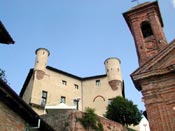 Battista
Farina, whose nickname Pinin means "small" in Piemonteis,
was born in Turin in 1893 to parents who were farmers from Cortanze,
now in the province of Asti. The tenth of eleven children, he began
working at an early age in his older brother's mechanics shop, where
he rose through the ranks to become the well-known automobile builder
Pininfarina. Battista
Farina, whose nickname Pinin means "small" in Piemonteis,
was born in Turin in 1893 to parents who were farmers from Cortanze,
now in the province of Asti. The tenth of eleven children, he began
working at an early age in his older brother's mechanics shop, where
he rose through the ranks to become the well-known automobile builder
Pininfarina.
Farina's grandparents lived in Cortanza and during his frequent
visits, above all during the grape harvest, he would admire the
beautiful medieval castle owned by the Marquises of the Roero (see
Silvano
Cerrato's photo, at left), dreaming of someday being the lord
of the castle. That dream came true in 1950. A man of many interests,
he founded schools and promoted many cultural and philanthropic
initiatives. In 1962, with a ministerial degree, he changed his
last name to Pininfarina, in consideration of his social and industrial
merits. He died in Losanna at the age of 73, leaving the company
presidency to his son Sergio.
For more on Pinin Farina, visit these sites:
http://www.pininfarina.it/eng/history/history/30_66.html
http://www.geocities.com/buonocunto/stilisti/pininfarina.html
Vini Piemontesi
Piedmont is, of course, one of the world's most celebrated wine
regions thanks to oenophiles' love
of Barolo and Barbaresco and everybody's knowledge of Asti Spumante.
And now Barbera (below left), Dolcetto, Brachetto, Moscato d'Asti
and other Piemontesi wines are becoming popular across the globe.
Two of the best-kept secrets in Piemontesi wines are Grignolino
(the name comes from "grignole,"
which is the Astigiani word for grape pips), which has an almost
orange color, and the super-rare Ruche' (pronounced roo-KAY),
picture below on the right, both of which have a delicious spiciness
and unusual flavors. Another is Freisa, a lightly fizzy red wine
that is refreshingly medium-bodied with hints of raspberries. All
three are best enjoyed young.
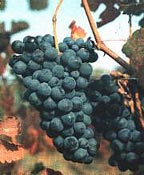 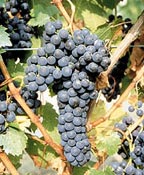
While we haven't come across these wines too much on this side of
the pond (although there are a few producers of grignolino in California,
and even one in northern Wisconsin) there is hope.
Recently we found that some distributors have Pio Cesare's grignolino
in their warehouses.
We acquired ours by asking our local wine shop to special order
it. Cantine Sant'Agata's 2000
Ruche di Castagnole Monferrato is being distributed in America by
John Givern Wines. We got ours
by calling Sam's
Wine in Chicago and talking to their Italian wine expert, Robert
Presley. Don't miss
out on the entire bounty of Piemontesi wines. Get your grignolino
now.
To read more stories like these, click here!
|


















 Angelino tapped to lead Mondo
Angelino tapped to lead Mondo  Lavish A+ magazine trumpets treasures of Provincia di Alessandria
Lavish A+ magazine trumpets treasures of Provincia di Alessandria 

 The
Assessorato per la Cultura for the city of Casale Monferrato has
published a wonderful anthology of poetry, songs and satire in the
dialect of the Monferrato Casalese. "Spirit Munfrin"
edited by Elio Botto, Teresio Malpassuto and Giorgio Milani has
more than 200 pages of works in dialect by Monferrini poets and
writers. There are also translations (into Italian but not English)
and short biographical sketches of the writers. There are also some
really wonderful old photographs by Francesco Negri, who died in
1924. What makes them special is the fact that they depict scenes
of everyday life, from work in the fields and rice paddies to children
playing and adults dancing. We've all seen historical photos
of the towns of the Monferrato or posed photos of people, but not
these lively pictures that open up a disappeared world to us.
The
Assessorato per la Cultura for the city of Casale Monferrato has
published a wonderful anthology of poetry, songs and satire in the
dialect of the Monferrato Casalese. "Spirit Munfrin"
edited by Elio Botto, Teresio Malpassuto and Giorgio Milani has
more than 200 pages of works in dialect by Monferrini poets and
writers. There are also translations (into Italian but not English)
and short biographical sketches of the writers. There are also some
really wonderful old photographs by Francesco Negri, who died in
1924. What makes them special is the fact that they depict scenes
of everyday life, from work in the fields and rice paddies to children
playing and adults dancing. We've all seen historical photos
of the towns of the Monferrato or posed photos of people, but not
these lively pictures that open up a disappeared world to us. A
slick, lovely Italian magazine called Meridiani, which is nearly
a book it's so thick, featured the Monferrato and the Langhe
together in the October 2003 issue.
A
slick, lovely Italian magazine called Meridiani, which is nearly
a book it's so thick, featured the Monferrato and the Langhe
together in the October 2003 issue.




 Some of you may have seen this poster for sale
Some of you may have seen this poster for sale Paolo
Conte was born 6 January 1937 in Asti and has had a lifelong passion
for jazz and the visual arts. He and his brother Giorgio, and
then he alone, would write songs inspired by books, films and
from actual experience. Conte worked for several years as a lawyer.
His performing career began on a small scale as a vibraphone player
in local and touring bands, with occasional foreign trips.
Paolo
Conte was born 6 January 1937 in Asti and has had a lifelong passion
for jazz and the visual arts. He and his brother Giorgio, and
then he alone, would write songs inspired by books, films and
from actual experience. Conte worked for several years as a lawyer.
His performing career began on a small scale as a vibraphone player
in local and touring bands, with occasional foreign trips.  Older
Piemontesi-Americans can likely remember a time when grignolino,
freisa and ruche were available in the United States, at least
in Piemontese neighborhoods like the one on Manhattan's West Side.
Ads from the 1920s and '30s boast of wine importers and distributors
who catered to these communities by supplying the wines they treasured.
Alas, those days are long gone.
Older
Piemontesi-Americans can likely remember a time when grignolino,
freisa and ruche were available in the United States, at least
in Piemontese neighborhoods like the one on Manhattan's West Side.
Ads from the 1920s and '30s boast of wine importers and distributors
who catered to these communities by supplying the wines they treasured.
Alas, those days are long gone.
 Luigi
Lavazza's name is a household word in Italy and many other countries
throughout the world. Now, it looks like
Luigi
Lavazza's name is a household word in Italy and many other countries
throughout the world. Now, it looks like 


 The
Baroque in Piemonte reached some remarkable heights and thanks to
architects like Juvarra and Magnocavallo, even small towns in the
Monferrato have some amazing examples of Piemontese Baroque buildings
(mostly churches). Juvarra, a Sicilian, designed a wonderful tower
in Camagna, but Magnocavallo is a hometown boy and is responsible
for some brilliant works.
The
Baroque in Piemonte reached some remarkable heights and thanks to
architects like Juvarra and Magnocavallo, even small towns in the
Monferrato have some amazing examples of Piemontese Baroque buildings
(mostly churches). Juvarra, a Sicilian, designed a wonderful tower
in Camagna, but Magnocavallo is a hometown boy and is responsible
for some brilliant works. Further
down this page, you'll find information on some traditional music
of the Monferrato. Now for something for the younger readers...
Further
down this page, you'll find information on some traditional music
of the Monferrato. Now for something for the younger readers...
 Although
the Feltrinelli family isn't originally from the Monferrato, Giangiacomo
Feltrinelli, whom this book is about, bought the lofty castle atop
the town of Villadeati in the late 1950s and the family has had
a presence there ever since.
Although
the Feltrinelli family isn't originally from the Monferrato, Giangiacomo
Feltrinelli, whom this book is about, bought the lofty castle atop
the town of Villadeati in the late 1950s and the family has had
a presence there ever since. There
are countless wine producers in the Monferrato and many towns have
their own co-ops where small growers can vinify their crops. One
of our favorites is Sette Colli (seven hills) in Moncalvo, on the
road to Casale.
There
are countless wine producers in the Monferrato and many towns have
their own co-ops where small growers can vinify their crops. One
of our favorites is Sette Colli (seven hills) in Moncalvo, on the
road to Casale.





 Battista
Farina, whose nickname Pinin means "small" in Piemonteis,
was born in Turin in 1893 to parents who were farmers from Cortanze,
now in the province of Asti. The tenth of eleven children, he began
working at an early age in his older brother's mechanics shop, where
he rose through the ranks to become the well-known automobile builder
Pininfarina.
Battista
Farina, whose nickname Pinin means "small" in Piemonteis,
was born in Turin in 1893 to parents who were farmers from Cortanze,
now in the province of Asti. The tenth of eleven children, he began
working at an early age in his older brother's mechanics shop, where
he rose through the ranks to become the well-known automobile builder
Pininfarina.
